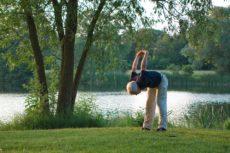Best Workout Plans For Older Adults
If you’re looking for our latest list of best elliptical machines for seniors, please see our most recent ranking, here.
Inactivity is a threat that adults must be mindful of as they age. A person who lives a sedentary lifestyle can fall victim to any number of ailments that can lead to illness,
Aerobic Exercises
According to the Centers for Disease Control and Prevention, aerobics is an important part when it comes to older adults staying as healthy as possible. Not only does it burn excess calories, but it also reduces cholesterol, lowers blood pressure, and helps keeps the heart healthy. The amount of aerobic exercise depends on several factors, such as the person’s level of fitness and the intensity of the workout. For instance a 30-minute workout from the Max Trainer M5 will burn a lot more calories that a traditional treadmill or elliptical. If in relatively good health and fitness, an older adult should get as much as 150 minutes of moderate-intensity aerobic activity per week. If performing aerobic activity that is of vigorous intensity, it should be for 75 minutes a week. When exercising at a level of moderate intensity, a person should be able to speak but not sing. Examples of moderate-intensity exercises include brisk walking, which is walking at a pace that is approximately three miles per hour. Bicycling at a pace that is less than 10 miles per hour, water aerobics, and even general gardening at home are also examples that are suitable for most older adults.
Activity is vigorous when the individual participating in it must catch their breath after speaking only a few words. In terms of heart rate, there will be a significant increase noted. Examples of vigorous-intensity workouts include swimming laps in a pool, jogging, running, speed-walking, jumping rope, and bicycling faster than 10 miles per hour. Activities that are the equivalent of vigorous exercise include playing tennis, hiking uphill, and heavy gardening that requires the use of a lawn mower, raking, or significant amounts of digging. Exercises on machines, such as an elliptical machine, are also examples of vigorous aerobic exercise. Often, elliptical machines and similar equipment are found in gyms.
- How Much Physical Activity Do Older Adults Need?
- What Are Some Aerobic Training Workouts and Routines?
- Seniors and Exercise
- Exercise Guidelines for Seniors
Muscle Strengthening
Muscle-strengthening exercises are an important part of any senior’s physical fitness regimen. These types of exercises help to prevent the loss of muscle that occurs as people age and will also help improve bone density. They are done using dumbbells, also known as free weights, or they may also be performed by the use of strengthening bands. People who have access to a fitness center or gym may utilize the weight machines and other heavy fitness equipment. If free weights, resistance bands, or a gym are not available, items such as filled grocery bags or jugs of water may be substituted for some of the exercises. When starting with weights for the first time, it is best to use lighter weights to begin with and move to heavier weights at a later time. Exercises that are performed should work out the arms, shoulders, legs, back, hips, chest, and abdomen. They are divided into exercises that work the upper body and those that work the lower body. Upper-body exercises may include side arm raises, elbow extensions, and wrist and arm curls. Knee curls, toe stands, and leg-strengthening exercises fall under exercises for the lower body.
Flexibility
Limited flexibility can become a problem with age. Muscles need to be stretched to prevent injury and to improve one’s range of motion and movement. Stretching is an exercise that should be done before any other type of exercise. Stretching muscles can help make them more flexible and prevent injury that more vigorous or difficult exercises may cause. Stretching before an exercise is typically referred to as warming up the muscles, while stretching after exercising is cooling down. There are stretches for the triceps, biceps, hamstrings, calves, quads, mid-back, and groin. When performing these stretches, the individual who is exercising should avoid bouncing during the stretch so as not to tear a muscle. Movements should be slow and smooth, and breathing should be natural. Both men and women should perform stretches in the same manner.
- Strength and Flexibility Training
- The Age Antidote
- Stretching and Flexibility
- Stretching Exercises for Seniors

